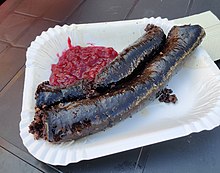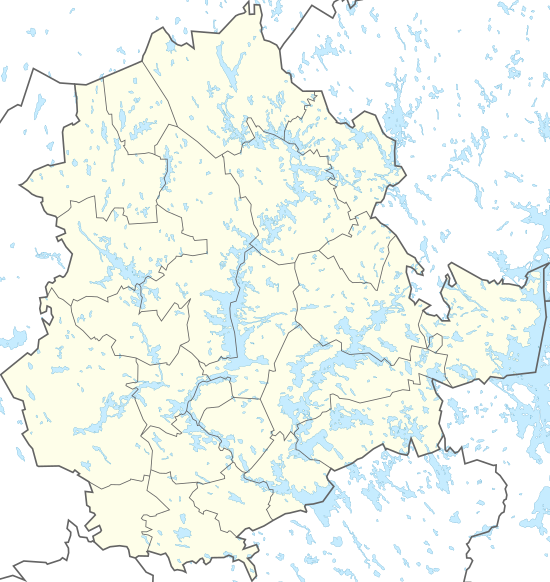Pirkanmaa
You can help expand this article with text translated from the corresponding article in Finnish. (June 2023) Click [show] for important translation instructions.
|
Pirkanmaa
Birkaland | |
|---|---|
| Region of Pirkanmaa Pirkanmaan maakunta (Finnish) Landskapet Birkaland (Swedish) | |
 Pirkanmaa on a map of Finland | |
| Coordinates: 61°42′N 23°43′E / 61.700°N 23.717°E | |
| Country | Finland |
| Historical province | Satakunta, Tavastia |
| Capital | Tampere |
| Other towns | Akaa, Ikaalinen, Kangasala, Mänttä-Vilppula, Nokia, Orivesi, Parkano, Sastamala, Valkeakoski, Virrat and Ylöjärvi |
| Area | |
• Total | 14,469.39 km2 (5,586.66 sq mi) |
| Population (2022) | |
• Total | 529,100 |
| • Density | 37/km2 (95/sq mi) |
| GDP | |
| • Total | €17.437 billion (2015) |
| • Per capita | €34,546 (2015) |
| Time zone | UTC+2 (EET) |
| • Summer (DST) | UTC+3 (EEST) |
| ISO 3166 code | FI-11 |
| NUTS | 192 |
| Regional animal | White-tailed deer (Odocoileus albavirginianus) |
| Regional bird | White wagtail (Motacilla alba) |
| Regional fish | Asp (Aspius aspius) |
| Regional flower | Bird cherry (Prunus padus) |
| Regional stone | Orbiculite |
| Regional lake | Lake Längelmävesi |
| Website | pirkanmaa.fi |
Pirkanmaa (Finnish: [ˈpirkɑˌmːɑː]; Swedish: Birkaland; Latin: Birkaria), also known as Tampere Region in government documents,[2] is a region of Finland. It borders the regions of Satakunta, South Ostrobothnia, Central Finland, Päijät-Häme, Kanta-Häme and Southwest Finland. Most of the water area in the Kokemäki River watershed is located in the Pirkanmaa region, although Lake Vanajavesi is partly in the Kanta-Häme region. The region got its name from Pirkkala, which in the Middle Ages comprised most of present-day Pirkanmaa.[3] Tampere is the regional center and capital of Pirkanmaa, and at the same time the largest city in the region.
The total population of Pirkanmaa was 529,100 on 30 June 2022,[4] which makes it the second largest among Finland's regions after Uusimaa. The population density is well over twice the Finnish average, and most of its population is largely concentrated in the Tampere metropolitan area.
History
[edit]Pirkanmaa has been inhabited for thousands of years. In the Bronze Age, agriculture replaced hunting, and in the Iron Age a settlement stretched from Eurajoki to Längelmäki, which was Finland's northernmost area of peasant culture from the 8th century. In the 11th century, the settlement was concentrated along River Kokemäenjoki and Lake Pyhäjärvi. In the 14th century, present-day Pirkanmaa was part of the historical Satakunta, the main part of which was Upper Satakunta and a small part of which was also Lower Satakunta. After the wilderness period, the absence of towns slowed down development. King Gustav III founded Tampere in 1775, and in the 1840s it became Finland's most important industrial centre. New inventions such as sawdust, cellulose and papermaking boosted development. Industries were established in Valkeakoski, Nokia and Mänttä, among others. Tampere became the centre of the province and a railway junction.
During the Finnish Civil War, Pirkanmaa was under the control of the Reds and Tampere was the centre of the Reds. After the war, industrialisation intensified. During the Winter War, Tampere and other cities were bombed. The County of Pirkanmaa was established in 1956. The county was also called Tammermaa, but gradually Pirkanmaa became the name of the region. In the 1950s, the only city in the province was Tampere, but from 1963 to 1977 the municipalities were made into cities. The number of municipalities decreased in the second half of the 20th century, and old place names were reintroduced as municipalities merged. In 1994 Finland was divided into 20 functional economic provinces, and Pirkanmaa was one of them.
Regional division
[edit]Historical provinces
[edit]Municipalities
[edit]The region of Pirkanmaa consists of 23 municipalities, 12 of which have city status (marked in bold).
Municipalities on the map
[edit]Sub-regions
[edit]North Western Pirkanmaa sub-region:
 Juupajoki
Juupajoki Mänttä-Vilppula (Mänttä-Filpula)
Mänttä-Vilppula (Mänttä-Filpula) Ruovesi
Ruovesi Virrat (Virdois)
Virrat (Virdois)
Southern Pirkanmaa sub-region:
 Akaa (Ackas)
Akaa (Ackas) Urjala (Urdiala)
Urjala (Urdiala) Valkeakoski
Valkeakoski
South Western Pirkanmaa sub-region:
 Punkalaidun (Pungalaitio)
Punkalaidun (Pungalaitio) Sastamala
Sastamala
List of municipalities
[edit]| Coat of arms |
Municipality | Population | Land area (km2) |
Density (/km2) |
Finnish speakers |
Swedish speakers |
Other speakers |
|---|---|---|---|---|---|---|---|
 |
Akaa | 16,383 | 293 | 56 | 97 % | 0.2 % | 3 % |
 |
Hämeenkyrö | 10,339 | 464 | 22 | 98 % | 0.2 % | 2 % |
 |
Ikaalinen | 6,766 | 750 | 9 | 96 % | 0.2 % | 5 % |
 |
Juupajoki | 1,666 | 258 | 6 | 101 % | 0.2 % | 2 % |
 |
Kangasala | 33,966 | 658 | 52 | 95 % | 0.2 % | 3 % |
 |
Kihniö | 1,699 | 357 | 5 | 101 % | 0 % | 2 % |
 |
Kuhmoinen | 2,037 | 661 | 3 | 100 % | 0.5 % | 2 % |
 |
Lempäälä | 24,815 | 270 | 92 | 96 % | 0.3 % | 3 % |
 |
Mänttä-Vilppula | 9,278 | 535 | 17 | 96 % | 0.2 % | 4 % |
 |
Nokia | 36,171 | 288 | 125 | 95 % | 0.3 % | 4 % |
 |
Orivesi | 8,866 | 800 | 11 | 97 % | 0.2 % | 2 % |
 |
Parkano | 6,071 | 853 | 7 | 98 % | 0.1 % | 3 % |
 |
Pirkkala | 21,034 | 81 | 258 | 94 % | 0.4 % | 5 % |
 |
Punkalaidun | 2,609 | 361 | 7 | 98 % | 0.1 % | 3 % |
 |
Pälkäne | 6,236 | 561 | 11 | 97 % | 0.4 % | 4 % |
 |
Ruovesi | 4,039 | 777 | 5 | 99 % | 0.3 % | 3 % |
 |
Sastamala | 23,457 | 1,429 | 16 | 97 % | 0.2 % | 3 % |
 |
Tampere | 260,358 | 525 | 496 | 87 % | 0.5 % | 10 % |
 |
Urjala | 4,492 | 476 | 9 | 98 % | 0.3 % | 3 % |
 |
Valkeakoski | 20,837 | 272 | 77 | 94 % | 0.2 % | 5 % |
 |
Vesilahti | 4,515 | 301 | 15 | 97 % | 0.5 % | 2 % |
 |
Virrat | 6,188 | 1,163 | 5 | 98 % | 0.1 % | 3 % |
 |
Ylöjärvi | 33,681 | 1,116 | 30 | 97 % | 0.4 % | 3 % |
| Total | 545,503 | 13,249 | 41 | 92 % | 0.4 % | 7 % |
Economy
[edit]
The Gross domestic product (GDP) of the region was 18.3 billion € in 2016, accounting for 8.5% of Finnish economic output. GDP per capita adjusted for purchasing power was €36,040 or 92% of the EU27 average in the same year. Pirkanmaa's GDP was the second highest among the regions and the seventh highest among the nineteen regions per capita.[5]
The economic structure of Pirkanmaa typically focuses on services for post-industrial society. A nationally significant ICT concentration has grown in Tampere. Thanks to its population base, the city is also a major trading center. Industry's share of value added and jobs in Pirkanmaa is higher than the Finnish average. The region is one of Finland's main centers of manufacturing, has a long tradition of industrial activity and a good education network. The industry is largely concentrated in Tampere and its surroundings, such as towns of Nokia and Valkeakoski. Mänttä-Vilppula is also a major industrial center. Agriculture accounts for a small share of economic activity. In the western part of the region, agricultural production is dominated by dairy cattle, in the south by cereals, and in the north by forestry.[6][7][8]
Language
[edit]Pirkanmaa is a rather linguistically homogeneous region: in 2018, almost 490,000 people, or about 95 per cent of the county's population, spoke Finnish as their mother tongue. For Finno-speakers, the national population share of Pirkanmaa was 10,1 per cent.[9] In the 2010s, the number of Finnish-speakers has increased only in Uusimaa, Pirkanmaa and Northern Ostrobothnia, and slightly in Southwest Finland and Åland.[10]
The Swedish-speaking settlement settled in Finland in the Middle Ages did not extend to the area of present-day Pirkanmaa, so the number and share of Finno-Swedes in the province is small. In 2018, about two thousand people spoke Swedish as their mother tongue in Pirkanmaa.[9] In 2017, 27 people spoke Sámi as their mother tongue in Pirkanmaa. The second most spoken language in Pirkanmaa is Russian, in 2018 it was used by four thousand people as their mother tongue.[9]
Regional council
[edit]The regional council is the main governing body for region and focuses primarily on urban planning. Like all regional councils, it is mandated by law.
Politics
[edit]Results of the 2019 Finnish parliamentary election in Pirkanmaa:
- Social Democratic Party 22.10%
- National Coalition Party 18.47%
- Finns Party 17.32%
- Green League 12.42%
- Centre Party 8.87%
- Left Alliance 8.14%
- Christian Democrats 5.74%
- Movement Now 2.40%
- Blue Reform 1.12%
- Seven Star Movement 0.46%
- Swedish People's Party 0.11%
- Other parties 2.85%
See also
[edit]- Birkarls
- Finnish national road 12
- Kokemäki River
- Lake Längelmävesi
- Lake Näsijärvi
- Pirkanmaa Constituency
- Tampere metropolitan area
References
[edit]- ^ Regions and Cities > Regional Statistics > Regional Economy > Regional GDP per Capita, OECD.Stats. Accessed on 16 November 2018.
- ^ "Welcome to the Tampere Region". Council of Tampere Region. Archived from the original on 2015-11-25. Retrieved 2013-06-20.
- ^ Viljo Rasila (1985). Pirkanmaan synty (in Finnish). Tampereen historiallinen seura. pp. 6–25.
- ^ "Preliminary population structure by Month, Area, Sex, Age and Information". Statistics Finland. 2022-07-21. Retrieved 2022-07-22.
- ^ "Tilastokeskuksen PX-Web-tietokannat" (in Finnish). Tilastokeskus. December 5, 2017. Retrieved January 10, 2021.
- ^ "Pirkanmaa – Maakunnan yleisesittely" (PDF) (in Finnish). Pirkanmaan liitto. 2014. Retrieved January 10, 2021.
- ^ "Pirkanmaan talous 2013" (PDF) (in Finnish). Pirkanmaan liitto. 2013. Retrieved January 10, 2021.
- ^ "Pirkanmaa – Maakuntakaava 2040" (PDF) (in Finnish). Pirkanmaan liitto. March 3, 2015. Retrieved January 10, 2021.
- ^ a b c d "Tilastokeskuksen PX-Web-tietokannat / Väestö 31.12. muuttujina Maakunta, Kieli, Ikä, Sukupuoli, Vuosi ja Tiedot". Suomen virallinen tilasto (SVT): Väestörakenne [verkkojulkaisu] (in Finnish). Helsinki: Tilastokeskus. March 29, 2019. ISSN 1797-5379. Retrieved January 10, 2021.
- ^ "Tilastokeskuksen PX-Web-tietokannat / Väestö 31.12. muuttujina Kieli, Maakunta, Ikä, Sukupuoli ja Vuosi". Suomen virallinen tilasto (SVT): Väestörakenne [verkkojulkaisu] (in Finnish). Helsinki: Tilastokeskus. March 29, 2017. ISSN 1797-5379. Retrieved January 10, 2021.
External links
[edit]![]() Media related to Pirkanmaa at Wikimedia Commons
Media related to Pirkanmaa at Wikimedia Commons
![]() Pirkanmaa travel guide from Wikivoyage
Pirkanmaa travel guide from Wikivoyage




